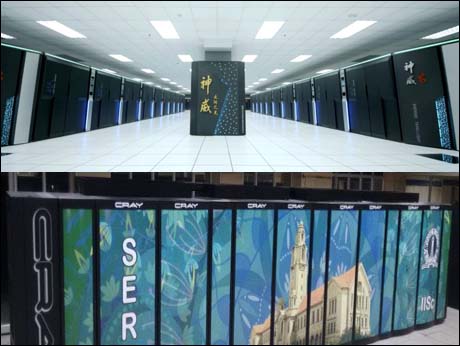
IndiaTechOnline Special Focus on Supercomputing
Frankfurt (Germany) and Berkeley (California, US), June 21 2016: The latest Top500 list of the world's fastest computers has a new entrant at the top: Sunway TaihuLight is the new No. 1 system with 93 petaflop/s (quadrillions of calculations per second) on the LINPACK benchmark. It is a system built entirely using 'ShenWei' processors designed and made in China. With this machine, China draws equal to the US in Overall Installations, ending a hegemony that has lasted all 20 years of this biannual listing.
At 3 teraflops, the new ShenWei silicon is on par with Intel’s “Knights Landing” Xeon Phi, another manycore design. Ironically it was the US embargo of high-end processors, such as the Xeon Phi, imposed on a number of Chinese supercomputing centres in April 2015, which precipitated a more concerted effort in that country to develop and manufacture such chips domestically.
A similar situation prevailed in India in the mid 1980s when the Missile Technology Control Regime of the US, denied supercomputer technology India for strategic applications and forced agencies like the Defence R&D Organisation (DRDO) and the Atomic Energy Commission (AEC), to develop their own respective High Performance Computing (HPC) machines, ANURAG and ANUPAM.
In another irony of history, we are today trying to join the MTCR and the Nuclear Suppliers Group (NSG) as a nuclear power. While China took just one year to overcome the US embargo to design and manufacture her own HPC processor, ShenWei, Indian co-processors designed within the ANURAG programme, never became part of a national thrust and today, neither of these well funded R&D organisations finds itself anywhere in the world's Top 500 systems.
In fact, according to the latest rankings, there are 9 India-based systems in the Top 500 ( Enter 'India' and '2016' in this sublist generator). They are identical to the last, November 2015 list except that two systems did not make the cut, as the entry level moved to 286.9 T Flops. The fastest Indian system, the 901.5 T Flops Cray XC40 at the Supercomputing Education and Research Centre Bangalore -- and for that matter, the next 3 India-based supercomputers are all imported American systems. The only Made-in-India machine albeit with US -made chips, is the Centre for Development for Advanced Computing's Param Yuva II at 388.4 T Flops.
China's dramatic lead in the global HPC scene contrasts sharply with the dithering and indecision that still accompanies efforts in India. The five years given for the $ 1 billion ( Rs 5000 crores/ Rs 50 billion) supercomputing programme announced with much fanfare in January 2012, by the then Prime Minister, Manmohan Singh are almost over. The new government in Delhi redusted this plan and announced it as a Rs 4500/ Rs 45 billion crore initiative of its own with a new target date, five years ahead -- 2017. The goal posts keep shifting; Rs 500 crores have been shaved off meanwhile and India still does not have a clear technology plan for how it is going to achieve petascale computing indigenously.
The issue in India is further muddied by divergent views on whether should achieve petaflops by building or buying. The 2012 announcement spoke of the intent to " build national capacity and capability in supercomputing ..." This leaves open an escape hatch: Capacity can as well be created by buying off the shelf -- a route that Indian academia led by the SERC in Bangalore, clearly prefers.
But the news from Top500 today is a warning and a lodestone; If you set it your mind to it like China-- you can do-it-yourself with spectacular success.
Now for the rest of the news from Top500:
The no. 2 system is also Chinese -- Tianhe-2, an Intel-based Chinese supercomputer that has claimed the No. 1 spot on the past six TOP500 lists.
Sunway TaihuLight, with 10,649,600 computing cores comprising 40,960 nodes, is twice as fast and three times as efficient as Tianhe-2, which posted a LINPACK performance of 33.86 petaflop/s. The peak power consumption under load (running the HPL benchmark) is at 15.37 MW, or 6 Gflops/Watt. This allows the TaihuLight system to grab one of the top spots on the Green500 in terms of the Performance/Power metric. Titan, a Cray XK7 system installed at the Department of Energy’s (DOE) Oak Ridge National Laboratory, is now the No. 3 system. It achieved 17.59 petaflop/s.TaihuLight is currently up and running at the National Supercomputing Center in the city of Wuxi, a manufacturing and technology hub, a two-hour drive west of Shanghai. The system will be used for various research and engineering work, in areas such as climate, weather & earth systems modeling, life science research, advanced manufacturing, and data analytics.
Rounding out the Top 10 are Sequoia, an IBM BlueGene/Q system installed at DOE’s Lawrence Livermore National Laboratory; Fujitsu’s K computer installed at the RIKEN Advanced Institute for Computational Science (AICS) in Kobe, Japan; Mira, a BlueGene/Q system installed at DOE’s Argonne National Laboratory; Trinity, a Cray X40 system installed at DOE/NNSA/LANL/SNL; Piz Daint, a Cray XC30 system installed at the Swiss National Supercomputing Centre and the most powerful system in Europe; Hazel Hen, a Cray XC40 system installed at HLRS in Stuttgart, Germany; and Shaheen II, a Cray XC40 system installed at King Abdullah University of Science and Technology (KAUST) in Saudi Arabia is at No. 10.
The European share of 105 systems (compared to 107 in November 2015) has fallen and is now lower than the dominant Asian share of 218 systems, up from 173 in November.
Other highlights:
The entry level (No. 500) to the list moved up to the 285.9 teraflop/s mark on the LINPACK benchmark, compared to 206.3 teraflop/s six months ago.